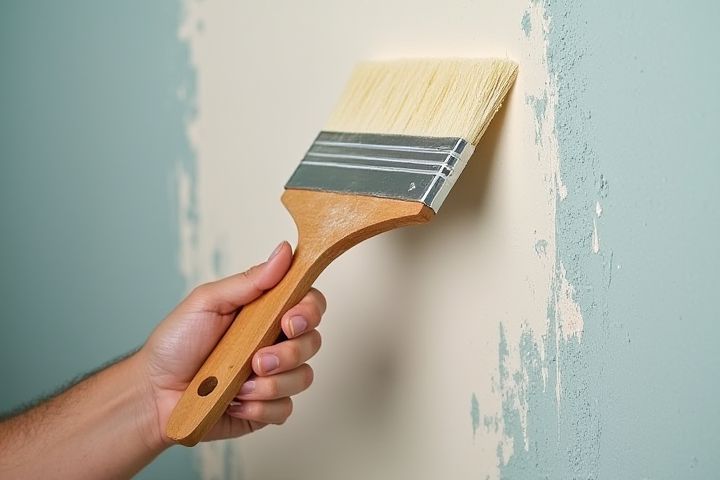
Assessing your skill level and experience with DIY projects is essential before deciding to undertake a house painting project. Preparing the walls by cleaning and patching any imperfections will significantly impact the final result. Selecting high-quality paint suited for your home's exterior or interior environment ensures durability and aesthetic appeal. Investing in the right tools, such as brushes, rollers, and drop cloths, can make the process smoother and more efficient. If you choose to DIY, taking your time and following a structured plan can lead to satisfying and professional-looking results.
Should I Diy A House Painting Project
Budget considerations
DIY house painting can significantly reduce costs, with average professional painting prices ranging from $2 to $6 per square foot. By opting for this approach, you can allocate saved funds towards high-quality paint, which typically retails for $20 to $60 per gallon. Furthermore, investing in essential tools such as brushes, rollers, and drop cloths, usually totaling around $100, can enhance the final results. Consider the time commitment involved; a DIY project can take anywhere from several hours to a few days, depending on your home's size and your painting experience.
Skill level assessment
Assessing your skill level is crucial before embarking on a DIY house painting project. Consider factors like your previous painting experience, familiarity with tools, and ability to handle detailed tasks. For example, if you've successfully completed smaller painting jobs or home improvement projects, you may find tackling a larger area more manageable. However, if you lack experience, hiring a professional could save you time and ensure a high-quality finish.
Surface preparation requirements
Proper surface preparation is essential for a successful house painting project, as it can account for up to 80% of the work's longevity and quality. Begin by thoroughly cleaning the surfaces to remove dirt, grease, and mildew, utilizing a pressure washer or a mixture of water and detergent. Next, inspect the area for cracks or peeling paint, and use a scraper to remove any loose materials; filling any gaps with high-quality caulk can provide a smooth finish. Lastly, sanding surfaces with 80 to 120-grit sandpaper will create a suitable texture for paint adhesion, ensuring a professional-looking result.
Time commitment
DIY house painting projects typically require a significant time commitment, often ranging from several hours to multiple days, depending on the project's scale. Preparing the surfaces, applying primer, and layering the paint can take up to 30% of the total time, especially for larger spaces. If you're aiming to complete a room in one weekend, expect to invest around 12 to 15 hours for the entire process, including drying time. Consider your own schedule and energy levels; if you have limited time, hiring a professional might save you both time and the burden of a time-consuming task.
Quality of finish expectations
When considering a DIY house painting project, it's essential to focus on your quality of finish expectations. A professional-grade finish typically requires proper surface preparation, including cleaning, sanding, and priming surfaces for optimal adhesion. Selecting high-quality paints that match your desired sheen and durability can significantly impact the final appearance. Investing time and effort into technique, such as brush strokes and even layering, will directly influence how satisfied you are with your finished product.
Necessary equipment and tools
Investing in essential equipment and tools is crucial for a successful DIY house painting project. You will need high-quality brushes, rollers, and trays, which typically range from $10 to $50 depending on size and brand. A sturdy ladder is vital for reaching higher areas, with options available from $50 to $200 based on height and type. Don't forget painter's tape, drop cloths, and a paint sprayer if you want a smoother finish--these can collectively cost around $25 to $150.
Safety precautions
When embarking on a DIY house painting project, safety precautions are paramount to ensure your well-being. Always wear protective gear, including a mask rated for paint fumes, goggles, and gloves, to shield against harmful chemicals and irritants found in paint. Ensure proper ventilation by opening windows or using fans to circulate air, minimizing the risk of inhaling toxic vapors. Additionally, keep your workspace organized by maintaining a clutter-free area and securing ladders or scaffolding to prevent falls, as falls are among the leading causes of injury in home improvement projects.
Color and paint type selection
Choosing the right color for your DIY house painting project can significantly enhance your home's aesthetic appeal. Experts recommend using a color wheel to identify complementary hues for different rooms, as specific colors can evoke emotions; for example, blues promote calmness while yellows energize spaces. When selecting paint type, consider the finish; satin and semi-gloss paints are ideal for high-traffic areas due to their durability and washability, while matte finishes work well in low-traffic spaces for a cozy look. Remember, high-quality paint can price from $30 to $100 per gallon, but investing in premium options can yield better results and longevity for your project.
Impact on property value
DIY house painting can significantly impact property value, with professionals estimating a fresh coat of paint can yield a 75% return on investment. High-quality paint jobs, especially in popular colors, can increase curb appeal and attract potential buyers. Studies show that homes with recently painted exteriors or interiors can command prices that are 5-10% higher than similar properties in less appealing condition. If you choose to take on a DIY project, ensure meticulous preparation and execution to maximize the positive effects on your home's market worth.
Weather and climate conditions
Weather and climate conditions significantly influence the success of your DIY house painting project. Optimal temperatures for exterior painting generally range from 50degF to 85degF (10degC to 29degC), as extreme heat or cold can lead to improper drying and potential paint failure. Humidity levels should ideally be below 70%, as excessive moisture can cause paint to bubble or peel. Be mindful of rain forecasts because applying paint when rain is imminent can compromise the finish and longevity of your work.
